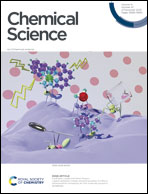Thermally activated delayed fluorescence in a deep red dinuclear iridium(iii) complex: a hidden mechanism for short luminescence lifetimes†
Abstract
The high luminescence efficiency of cyclometallated iridium(III) complexes, including those widely used in OLEDs, is typically attributed solely to the formally spin-forbidden phosphorescence process being facilitated by spin–orbit coupling with the Ir(III) centre. In this work, we provide unequivocal evidence that an additional mechanism can also participate, namely a thermally activated delayed fluorescence (TADF) pathway. TADF is well-established in other materials, including in purely organic compounds, but has never been observed in iridium complexes. Our findings may transform the design of iridium(III) complexes by including an additional, faster fluorescent radiative decay pathway. We discover it here in a new dinuclear complex, 1, of the form [Ir(N^C)2]2(μ-L), where N^C represents a conventional N^C-cyclometallating ligand, and L is a bis-N^O-chelating bridging ligand derived from 4,6-bis(2-hydroxyphenyl)-pyrimidine. Complex 1 forms selectively as the rac diastereoisomer upon reaction of [Ir(N^C)2(μ-Cl)]2 with H2L under mild conditions, with none of the alternative meso isomer being separated. Its structure is confirmed by X-ray diffraction. Complex 1 displays deep-red luminescence in solution or in polystyrene film at room temperature (λem = 643 nm). Variable-temperature emission spectroscopy uncovers the TADF pathway, involving the thermally activated re-population of S1 from T1. At room temperature, TADF reduces the photoluminescence lifetime in film by a factor of around 2, to 1 μs. The TADF pathway is associated with a small S1–T1 energy gap ΔEST of approximately 50 meV. Calculations that take into account the splitting of the T1 sublevels through spin–orbit coupling perfectly reproduce the experimentally observed temperature-dependence of the lifetime over the range 20–300K. A solution-processed OLED comprising 1 doped into the emitting layer at 5 wt% displays red electroluminescence, λEL = 625 nm, with an EQE of 5.5% and maximum luminance of 6300 cd m−2.

- This article is part of the themed collection: Most popular 2023 inorganic chemistry articles


 Please wait while we load your content...
Please wait while we load your content...